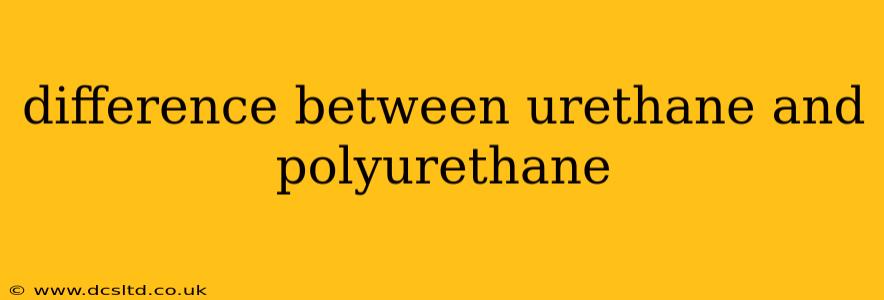The Difference Between Urethane and Polyurethane: Understanding the Chemistry and Applications
The terms "urethane" and "polyurethane" are often used interchangeably, leading to confusion. However, there's a crucial distinction: urethane is a functional group, while polyurethane is a polymer containing many urethane groups. Understanding this fundamental difference clarifies their diverse applications.
What is Urethane?
Urethane, chemically known as a carbamate, is a specific chemical group (-NH-COO-) formed by the reaction of an isocyanate (-N=C=O) with an alcohol (-OH). Think of it as a building block, a crucial component in creating larger molecules. It's not a material in itself, but rather a crucial part of the structure of many materials, including polyurethanes.
What is Polyurethane?
Polyurethane is a large polymer, meaning it's a long chain of repeating units. These repeating units contain the urethane group mentioned above. The properties of polyurethane vary widely depending on the specific starting materials (isocyanates and alcohols) used in its synthesis. This allows for tailoring the final product to a wide range of applications.
Key Differences Summarized:
| Feature | Urethane | Polyurethane |
|---|---|---|
| Type | Functional group | Polymer |
| Structure | Single chemical group (-NH-COO-) | Long chain of repeating units with -NH-COO- |
| Properties | Doesn't possess independent properties | Wide range of properties depending on formulation |
| Applications | Component of larger molecules | Diverse applications (see below) |
What are the different types of polyurethane?
The vast range of polyurethane applications stems from its versatility. By changing the isocyanates and polyols (alcohols) used in its production, manufacturers can adjust the final product's properties to suit diverse needs. Some common types include:
- Rigid Polyurethane Foam: Used in insulation due to its excellent thermal insulation properties. Think refrigerator insulation or building insulation.
- Flexible Polyurethane Foam: Used in cushioning, mattresses, and furniture due to its ability to absorb shock and provide comfort.
- Polyurethane Elastomers: These are strong, flexible materials used in wheels, seals, and other elastic components.
- Polyurethane Coatings: These are used in paints, varnishes, and protective coatings due to their durability and resistance to abrasion.
What are the different applications of polyurethane?
The diverse nature of polyurethane makes it incredibly versatile. Its applications are vast and span numerous industries:
- Automotive: Seat cushions, dashboards, bumpers, and other interior and exterior components.
- Construction: Insulation, roofing membranes, sealants, and coatings.
- Furniture: Cushioning, upholstery, and coatings.
- Textiles: Clothing, shoes, and other fabrics.
- Electronics: Coatings and insulation.
How is polyurethane made?
Polyurethane is synthesized through a reaction between diisocyanates and polyols (polyhydroxy compounds). This reaction is known as polyaddition. The precise ratio and type of isocyanates and polyols used determine the final properties of the polyurethane. Catalysts and other additives are often included to control the reaction rate and optimize the desired properties.
What are the advantages of polyurethane?
Polyurethane offers several significant advantages:
- Versatility: Its properties can be tailored to specific applications.
- Durability: Many polyurethane products are highly resistant to wear and tear.
- Flexibility: Can be made rigid, flexible, or elastomeric.
- Excellent insulation properties: Effective thermal and acoustic insulation.
What are some common misconceptions about polyurethane and urethane?
A common misconception is that urethane and polyurethane are the same thing. As explained earlier, urethane is a functional group, while polyurethane is a polymer containing many urethane groups. Another misconception is that all polyurethane is the same. The vast variety of polyurethane types highlights its diverse properties and applications, tailored to different requirements.
In conclusion, understanding the difference between urethane (the functional group) and polyurethane (the polymer) is crucial for appreciating the versatility and widespread applications of this important material in various industries. The specific properties of any polyurethane product are dictated by the precise chemical composition during its manufacture, allowing for seemingly endless possibilities.
